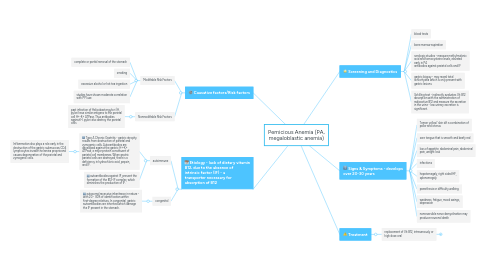
1. Causative factors/Risk factors
1.1. Modifiable Risk Factors
1.1.1. complete or partial removal of the stomach
1.1.2. smoking
1.1.3. excessive alcohol or hot tea ingestion
1.1.4. studies have shown moderate correlation with PPI use
1.2. Nonmodifiable Risk Factors
1.2.1. past infection of Helicobacter pylori (H. pylori have similar antigens to the parietal cell H+-K+ ATPase. Thus antibodies against H. pylori also destroy the parietal cells
2. Etiology - lack of dietary vitamin B12, due to the absence of intrinsic factor (IF) - a transporter necessary for absorption of B12
2.1. autoimmune
2.1.1. Type A Chronic Gastritis - gastric atrophy results from destruction of parietal and zymogenic cells. Autoantibodies are developed against the gastric H+-K+ ATPase, a major protein constituent of parietal cell membranes. When gastric parietal cells are destroyed, there is a deficiency in hydrochloric acid, pepsin, and IF.
2.1.1.1. Inflammation also plays a role early in the destruction of the gastric submucosa. CD4 lymphocytes invade the lamina propria and causes degeneration of the parietal and zymogenic cells.
2.1.2. autoantibodies against IF, prevent the formation of the B12-IF complex, which diminishes the production of IF.
2.2. congenital
2.2.1. autosomal recessive inheritance in nature - with 20 - 30% of identification within first-degree relatives. In congenital, gastric autoantibodies are inherited which damage the IF present in the stomach.
3. Screening and Diagnostics
3.1. blood tests
3.2. bone marrow aspiration
3.3. serologic studies - measure methylmalonic acid and homocysteine levels, elevated early in PA antibodies against parietal cells and IF
3.4. gastric biopsy - may reveal total achlorhydria which is only present with gastric lesions
3.5. Schilling test - indirectly evaluates Vit B12 absorption with the administration of radioactive B12 and measure the excretion in the urine - low urinary excretion is significant.
4. Signs & Symptoms - develops over 20-30 years
4.1. "lemon yellow" skin d/t a combination of pallor and icterus
4.2. sore tongue that is smooth and beefy red
4.3. loss of appetite, abdominal pain, abdominal pain, weight loss
4.4. infections
4.5. hepatomegaly, right sided HF, splenomegaly
4.6. paresthesia or difficulty walking.
4.7. weakness, fatigue, mood swings, depression
4.8. nonreversible nerve demyelination may produce neuronal death
5. Treatment
5.1. replacement of Vit B12, intravenously or high dose oral
5.1.1. Materials
5.1.2. Personnel
5.1.3. Services
5.1.4. Duration
